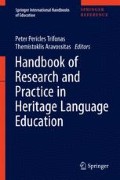Abstract
The Bora language is spoken by nearly 2000 people, members of an indigenous group that was persecuted and exploited during the Amazon rubber boom. They began learning Spanish early in the twentieth century, while leaving Bora behind. During 2015, after the formalization of the Bora alphabet, the Bora communities that live by the Ampiyacu, Yaguasyacu, and Amazon rivers started to teach their language again. This has resulted into a new pride among the Bora speakers leading them to the production of new texts in their native language and the construction of their indigenous identity. At the same time, as they discuss what graphemes should be used in their alphabet, they reveal ideologies about how their language should be written and what is actually a language for them. On the one hand, they respect the Spanish tradition for some consonants, like <c>; but, on the other hand, they prefer new graphemes that reveal their indigenous status, like the <ɨ> vowel.
Access this chapter
Tax calculation will be finalised at checkout
Purchases are for personal use only
References
Aikhenvald, A. Y. (2002). Language contact in amazonia. Oxford: Oxford University Press.
Aikhenvald, A. Y. (2012). The languages of the amazon. Oxford: Oxford University Press.
Aschmann, R. (1993). Proto Witotoan (Vol. 114). Dallas: Summer Institute of Linguistics/University of Texas at Arlington.
Benwell, B., & Stokoe, E. (2010). Discourse & identity. Edinburgh: Edinburgh University Press.
Chirif, A. (2014). Pueblo de la yuca brava. Historia y culinaria. Copenhague/Lima/Vaud: International Work Group for Indigenous Affairs/Instituto del Bien Común y Nouvelle Plànete.
Costa, J., & Gasquet-Cyrus, M. (2013). What is language revitalization really about? Competing language revitalization movements in provence. In M. C. Jones & S. Ogilvie (Eds.), Keeping languages alive. Documentation, pedagogy and revitalization. Oxford: Cambridge University Press.
Espinosa, O. (2009). “Salvajes opuestos al progreso”: Aproximaciones históricas y antropológicas a las movilizaciones indígenas en la Amazonía peruana. Anthropologica, 27(27), 123–168.
Fischman, J. (Ed.). (1977). Advances in the creation and revision of writing systems. The Hague: Mouton.
Gasché, J., & Ruíz-Mibeco, M. (1998). Muumune Lecto-escritura en la lengua bora. Iquitos: FORMABIAP & Ministerio de Educación.
Hickey, R. (Ed.). (2013). The handbook of language contact. Oxford: Wiley-Blackwell.
Jaffe, A., Androutsopoulos, J., Sebba, M., & Johnson, S. (Eds.). (2012). Orthography as social action: Scripts, spelling, identity and power. New York: Mouton de Gruyter.
Jaffe, A. (2015). Defining the new speaker: Theoretical perspectives and learner trajectories. International Journal of the Sociology of Language, 231, 21–44.
Jones, M. C., & Ogilvie, S. (Eds.). (2013). Keeping languages alive. Documentation, pedagogy and revitalization. Oxford: Cambridge University Press.
Lagos, O. (2012). Arana rey del caucho. Tierra Nueva: Iquitos.
Ministerio de Cultura: Base de Datos de Pueblos Indígenas u Originarios [updated 24 June 2014; cited 25 June 2014]. Available from: http://bdpi.cultura.gob.pe
Ministerio de Educación. Hacia una educación intercultural bilingüe de calidad: propuesta pedagógica. Lima: Minedu.
Napurí, A. (2016). Wekama (Shawi) & Tédújukó (Bora): Language politics in Peru after de period of political violence. Language & conflict: Politics of language and identity across contexts at school of Oriental & African Studies, University of London.
O’Laoire, M. (2008). Indigenous language revitalisation and globalization. Te Kaharoa, 1, 203–216.
Sebba, M. (2009). Sociolinguistic approaches to writing systems research. Writing Systems Research, 1(1), 35–49.
Sebba, M. (2012). Multilingualism in written discourse: An approach to the analysis of multilingual texts. International Journal of Bilingualism, 17(1), 97–118.
Steward, J. (1948). The Witotan tribes. The handbook of South American Indians. Vol. 3. Washington, DC: Smithsonian Institute.
Thiesen, W. (1996). Gramatica del idioma bora. Lima: Instituto Lingüístico de Verano y MINEDU.
Thiesen, W., & Thiesen, E. (1998). Diccionario bora-castellano castellano-bora, Serie Lingüística Peruana (Vol. 46). Lima: ILV.
Thiesen, W., & Weber, D. (2012). A grammar of bora with special attention to tone. SIL International: Dallas.
Zariquiey, R. (2014). Grammatical relations and case marking in Kakataibo (Panoan, Perú): When notion of split is just not enough. Eugene: University of Oregon.
Zavala, V., Mujica, L., Córdova, G., & Ardito, W. (2014). Qichwasimirayku: Batallas por el quechua. Fondo Editorial de la PUCP: Lima.
Acknowledgment
This work was funded by the Dirección de Gestión de la Investigación at the PUCP through grant 2015-1-0070.
Author information
Authors and Affiliations
Corresponding author
Editor information
Editors and Affiliations
Rights and permissions
Copyright information
© 2018 Springer International Publishing AG
About this entry
Cite this entry
Napurí, A. (2018). Revitalization of the Bora Language. In: Trifonas, P., Aravossitas, T. (eds) Handbook of Research and Practice in Heritage Language Education. Springer International Handbooks of Education. Springer, Cham. https://doi.org/10.1007/978-3-319-44694-3_24
Download citation
DOI: https://doi.org/10.1007/978-3-319-44694-3_24
Published:
Publisher Name: Springer, Cham
Print ISBN: 978-3-319-44692-9
Online ISBN: 978-3-319-44694-3
eBook Packages: EducationReference Module Humanities and Social SciencesReference Module Education

